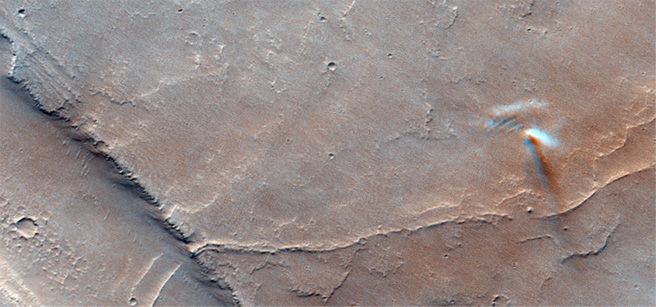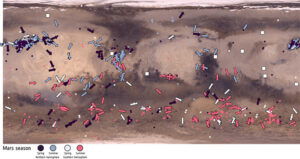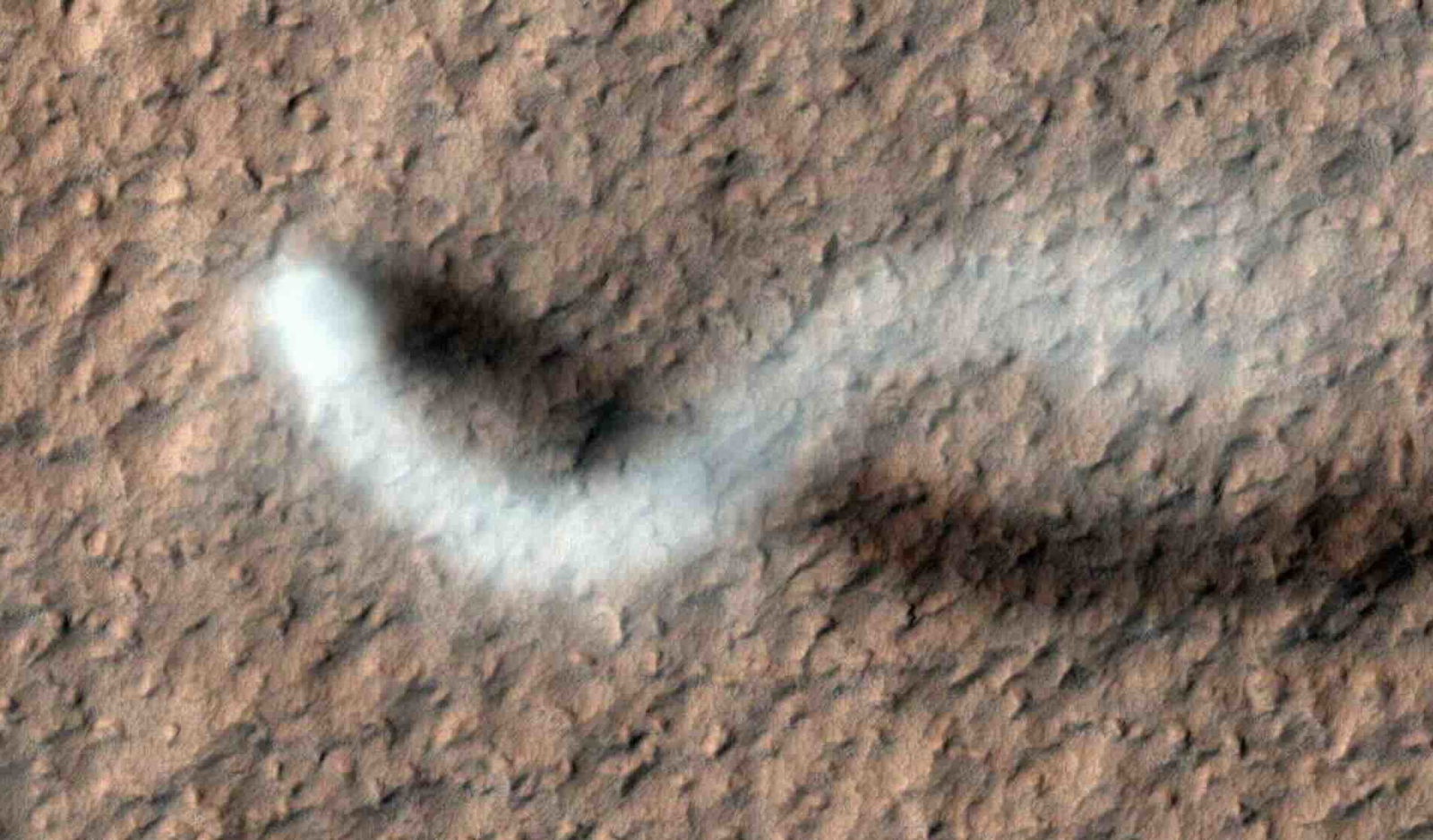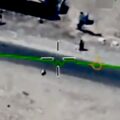Martian dust devils that have long fascinated scientists have finally been cataloged and tracked, providing unexpected new insights into the climate on Mars, which are already being applied toward future mission planning.
Similar to tornadoes, the dust devils consist of whirlwinds pushing around dust to sweep the Martian surface. The new analysis reveals 1039 dust devil observations collected over 20 years by the European Space Agency’s Mars Express and ExoMars Trace Gas Orbiter spacecraft, as revealed in a new paper published in Science Advances.
A Catalogue of Dust Devils
Dust has a variety of impacts on the Martian environment. Blanketing the atmosphere, it can block sunlight and cause significant reductions in daytime temperatures, while also trapping heat to increase nighttime temperatures. Dust particles can also serve as the nucleus for cloud formation, and storms that carry it can even reduce Mars’s already limited water supply by helping to facilitate its escape into space.
 Dust devils are frequently captured in imagery of the Martian surface (Image Credit: ESA/TGO/CaSSIS).
Dust devils are frequently captured in imagery of the Martian surface (Image Credit: ESA/TGO/CaSSIS).
That lack of water from rain within the Martian atmosphere prevents dust from being pulled out of the air, allowing it to linger for extended periods. This makes understanding how dust enters the atmosphere from a resting place on the surface all the more critical to understanding the planet’s climate.
Valentin Bickel of the University of Bern in Switzerland led the recent research project to assemble the massive new collection of dust devil observations. Researchers have monitored Martian dust storms for decades, but this is the first time their motions have been tracked across the Red Planet.
“Dust devils make the normally invisible wind visible,” Valentin explained. “By measuring their speed and direction of travel we have started mapping the wind all over Mars’s surface. This was impossible before because we didn’t have enough data to make this kind of measurement on a global scale.”
Tracking Martian Wind
Bickel’s team trained a neural network to accurately identify dust devils from images, before feeding it a torrent of data from Mars Express and ExoMars TGO. In addition to helping develop the catalogue of 1039 dust devils, the system also identified the direction of motion for 373 of them.
Valentin’s work ironically made use of the usually unwanted offsets found when combining multiple views collected by Mars Express and ExoMars TGO, which were never designed with tracking wind speeds in mind. Up to 9 images are collected in each observation, which have a delay ranging from 7 to 19 seconds. By monitoring the differences in the dust devils’ locations and comparing those to known delays, the researchers could determine the wind speed.
“It’s great to see researchers using Mars Express and ExoMars TGO for totally unexpected research,” commented Colin Wilson, ESA project scientist for both missions. “Dust affects everything on Mars – from local weather conditions to how well we can take images from orbit. It’s difficult to understate the importance of the dust cycle.”
 Map showing active dust devils during local spring and summer in Mars’s northern and southern hemispheres, with dots denoting dust devils with only location information and arrows displaying directional information. Credit: ExoMars TGO data: ESA/TGO/CaSSIS; Mars Express data: ESA/DLR/FU Berlin; Background: NASA Viking colour mosaic
Map showing active dust devils during local spring and summer in Mars’s northern and southern hemispheres, with dots denoting dust devils with only location information and arrows displaying directional information. Credit: ExoMars TGO data: ESA/TGO/CaSSIS; Mars Express data: ESA/DLR/FU Berlin; Background: NASA Viking colour mosaic
Dust Devils Revealed
Each of these identifications were plotted on a map of Mars, demonstrating that while dust devils travel the entire surface, many originate from specific source locations. One of these common origination points is Amazonis Planitia, a region known to be covered in fine dust and sand.
The most surprising development from the work was the speed at which dust devils were moving. Tracking winds on Mars can be challenging due to the Red Planet’s thin atmosphere. Wind speeds of even 100 kilometers per hour would be almost imperceptible to a human standing on the Martian surface. The speeds identified in the new tracking topped out at 158 kilometers per hour, far higher than anything previously recorded by a Mar rover.
Finding these unexpected high speeds has several implications for our understanding of Martian weather. One of these involves how they may be help to lift even more dust into the air than previously expected.
Lastly, the work also helped identify when dust devils occur most frequently. The spring and summer seasons tend to generate the most significant amount of these storms. Generally, they are daytime events, most common between 11:00 and 14:00 local time, and last only a few minutes. Notably, their behavior mimics that of terrestrial dust storms, which typically occur during the summer months and at midday.
Planning Mars Missions
The project represents a significant step toward developing a broader understanding of the Martian climate. Records compiled by Mars rovers like Perseverance and Curiosity are helpful, but collating these satellite observations provides a high-level understanding of the entire Martian weather system.
“Information on wind speeds and directions is also really important when planning the arrival of future landers and rovers at Mars,” says Valentin. “Our measurements could help scientists build up an understanding of wind conditions at a landing site before touchdown, which could help them estimate how much dust might settle on a rover’s solar panels – and therefore how often they should self-clean.”
In the most immediate term, mitigating the dust storms’ tendency to deposit dust that blocks the solar panels on Mars rovers is the project’s first practical application. The ESA is already taking action based on the new information, scheduling the 2030 ExoMars Rosalind Franklin rover touchdown to avoid dust storm season.
While the new work is an impressive start, the publicly available catalog is just a starting point for continued dust devil research. Further analysis will enable scientists to develop increasingly robust Martian climate models.
The paper, “Dust Devil Migration Patterns Reveal Strong Near-surface Winds across Mars,” appeared in Science Advances on October 8, 2025.
Ryan Whalen covers science and technology for The Debrief. He holds an MA in History and a Master of Library and Information Science with a certificate in Data Science. He can be contacted at ryan@thedebrief.org, and follow him on Twitter @mdntwvlf.


